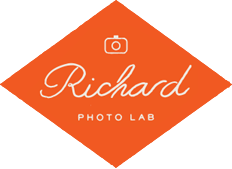Richard's Branding Boot Camp for Photographers
"Branding" seems like a buzzword that gets thrown around a lot, since nowadays being an entrepreneur is just a click away. The internet and social media have made it much simpler to start a business or personal brand (marketing one’s self and career as a brand) with seemingly less investment upfront. #marketingbudgetwin
What’s in a brand?
Building an effective brand is important to becoming a successful business. It can elevate the perceived value of a company, but it can just as easily destroy it (even when the products/services are top-notch).
Here at Richard Photo Lab’s “Branding Boot Camp”, we’re going to break down the foundational elements of a photographer’s brand and then pose some questions/exercises to get you started on forming your own brand as a photographer!
YOUR PHOTOGRAPHY STYLE
Before you can even think about starting a digital or film photography business, you need to establish who you are as an artist and the kind of photos you love to make.
Have you ever noticed there are images you can look at and immediately recognize the photographer? That’s because they have defined their style so clearly and execute it so consistently.
Here’s a lineup of digital images from our pals Jose Villa, Ashley Woodson Bailey, and Max Wanger. Look at the composition, the colors, the contrast, the je ne sais quoi… Each artist’s work has a cohesive “flavor”, even if it evolves over time.



The correlation between "success" and a recognizable, consistent brand style should be taken seriously.
BOOT CAMP EXERCISE:
- Do you know what “looks” you like and are they consistent?
- Describe your style in both visual terms (cool colors, high contrast, small depth of field, etc.) and feelings (romantic, edgy, ethereal, candid, etc.).
- Do you know how to achieve the look that you like? (If you don’t, you aren’t ready to build a brand yet—keep at it, friend!)
YOUR BRAND PERSONALITY
A “brand personality” is the emotional/human connection of a brand. It’s the character traits that are expressed through a business’s voice and visual appearance. These are the foundations for your “brand identity”, and they will guide your strategies for representing your business & brand in all forms.
You’ll find that the characteristics of your brand personality will be similar to the sentiments you provided in the exercise above about your style. But when describing your brand personality, you’ll want to focus on the representation of your business as a whole more than the creative representation of your art.
BOOT CAMP EXERCISE:
- If your brand were a person, what would it be like? Who is it? what is important to it? How does it interact with the world around it?
- Who is your brand speaking to? Would your typical customer or your demographic “be—or want to be— friends” with your brand persona?
- Start to discover and define your brand personality by choosing between the following descriptions:
- Professional/Corporate vs Personable
- Planned vs Spontaneous
- Traditional vs Modern
- Established vs Cutting Edge
- Modest vs Daring
- Formal vs Casual
- Serious vs Funny
- Sophisticated vs Rugged
- Accessible vs Exclusive
- Reliable vs Surprising
- Premium vs Economical
- Rigid vs Flexible
- Young & Fresh vs Mature & Wise
YOUR BRAND IDENTITY
Often, the difference between brand personality and brand identity can get muddled. Where brand personality focuses on the human connection, brand identity focuses on how these traits are relayed to an audience. Basically, it’s components like logos, slogans, fonts, colors, tone of voice, and additional imagery/iconography used.
These elements should embody the attributes you identified as your brand personality, but they should also be used consistently within your brand communications (like your website, business card, social media, and any other tools you are using to represent your brand).
You and your business are unique. So while there may be commonalities in brand identity amongst others in your industry simply because you have the same target audience, try to pinpoint and capitalize the unique selling points of your brand into visual elements that can make you stand out.
Let’s look at three different photographers—all in the wedding industry—and how they’ve created distinct brand identities that send a message about their individual brand personas. Is the way you interpret each one similar to how we interpret them? That’s exactly what you’ll want in a brand identity.

Take a close look at our friend Caroline Tran’s logo (above), and how its design sends a message about her photography business and imagery.
The desaturated, deep purple color reads as calm and gracious. The serif font and clean damask symbols give off a mature, refined vibe, but using all lowercase letters adds a familiar, comfortable element.
If you’re aware of Caroline and her work, you’ll find that her photography, as well as her professional demeanor, creates the same impressions that her logo exemplifies.

Jen Huang’s logo (above) features her signature: it’s clean and strong but still relays a personal touch. Her fresh, light-filled photography is highlighted through her brand by always utilizing minimal text, polished fonts, a clear visual hierarchy in her text via the use of capitalization, and playful yet uncluttered graphic details and layouts (Jen’s blog, above).

Seth and Tenielle Mourra of Feather and Stone also feature hand-lettering in their logo (above, top left). But, notice how very different their custom lettering and illustrated elements (by Chelsea Petaja) feel from our previous example. The look and usage of these components translates to an earthy, harmonious, and organically earnest feeling.
By regularly incorporating this lettering and illustrative style throughout their web presence (excerpts from Feather and Stone’s website, above right and left—note site navigation, social media links, title text/art), Feather and Stone reinforce these sentiments about the business consistently and coherently.
BOOT CAMP EXERCISE:
- Narrow down your brand personality to the five most clear and distinct traits you can. Try to assign one or two visual descriptors to each trait (for example, the trait “spontaneous” might be associated with visual terms like “bright” or “scattered”, or the trait “modern” might bring to mind visual terms like “minimalist” or “monotone”).
- Check out these common associations between visual elements and the feelings they incite. While connected perceptions are unique to each individual, it can help jumpstart ideas on how you can translate your brand personality into a brand identity:
COLORS
- Cool colors: tranquil, comfortable, trustworthy, wise
- Warm colors: optimistic, inviting, confident, stimulating
- Neutral colors: simple, balanced, composed, absolute
- Complementary colors: harmonious, appeasing, inclusive
- High-contrast colors: active, impactful, energized
- Saturated: powerful, extreme, bold
- Desaturated: subtle, stable, humble
TYPOGRAPHY
- Serif: precise, formal, mature, absolute
- Sans serif: easy-going, approachable, contemporary
- Script: elegant, elaborate, distinct
- Handwritten: natural, sensible, unassuming
- Uppercase: rousing, bold, dominant
- Lowercase: carefree, colloquial, intimate,
- Titlecase: trustworthy, reliable, pragmatic
SHAPES AND LINES
- Geometric: organization, efficiency, balance
- Organic: agreeable, spontaneous, youthful
- Circles/Ovals: unity, wholeness, movement, eternity
- Squares/Rectangles and Triangles: stability, professionalism, strength
- Horizontal shapes and lines: community, peace, relaxation
- Vertical shapes and lines: strength, vigor, intensity
YOUR BRAND (PINKY) PROMISE
Every business makes a promise to their customers to deliver a product or service. When you pair the tangible deliverables with the value, experience, and feelings your clients walk away with, you have a “brand promise”. It’s what your client “gets” from your business.
You communicate your brand promise before a potential client even decides if they want to work with you… You communicate directly by showing your portfolio, providing service packages, etc., and indirectly through your brand identity.
Some food for thought: what are the consequences for your business if you don’t live up to your brand promise?
BOOT CAMP EXERCISE:
- What kind of experience can clients expect to have while you’re shooting?
- What tangibles will you provide to your clients before and after a shoot?
- What value do you add as their photographer?
- How will clients feel when (and after) working with you?
YOUR BRAND PERCEPTION
All the stuff we covered above doesn’t mean jack unless your (potential) customers recognize all the qualities and values you worked so hard to define for your business. So, put yourself in their shoes when you think about your brand persona, brand identity, and brand promise!
Ultimately, the consumer decides what your brand truly means. You just have to do your best to influence this perception before someone becomes a client, when they are actively your customer, and through your follow-up afterwards.
Furthermore, brand perception is unmistakably linked to the perceived dollar-value of your services. Outside of the market variables that you can’t control (like supply & demand, geography, etc.), how much you can charge for your work is largely influenced by brand perception because it impacts a client’s “price sensitivity” (how much a client is happily willing to pay for your services).
BOOT CAMP EXERCISE:
- What are your brand touchpoints (the places that a customer comes in contact with your brand)? Is your brand consistently represented in each?
- How does your own appearance/way you present yourself to clients affect the perception of your brand?
- How do you keep in touch with clients? How does this affect their perception of your brand?
- How do you deal with problems that arise?
- How do you nurture your business relationships over time?
- What methods do you use to figure out what your brand perception is?
Even after your brand has been built, your journey in branding isn’t over. Think full-circle! Listen to your customer's honest feedback and course-correct on a regular basis.
According to our friend Craig Johnson, President of Matchstic (the awesome-sauce branding agency that helped us with our rebrand efforts), “You can do all the things needed to develop your style, identity, personality, and business promise(s) that shape a consistent brand perception.”
“But, if you don’t practice listening to the customer and course-correcting any of the four elements that create the perception, then you will never truly know if your brand is connecting with the customer as intended. Sure, you can create all the elements that make up a ‘high-end’ brand, but how do you really know that you’ve accomplished that?”
Craig recommends revisiting your efforts every 12-24 months. Start by asking your customers two simple questions to shed some light on which brand elements you should course-correct: “When I say [my business name], what is the first word that comes to mind?” and “How would you describe my business in one sentence?”
Phew! Yep, it’s a lot to think about… and we know that it can feel overwhelming at first—trust us when we say “we’ve been through this, too”. Don’t fret, friends! It will be so worth it in the end. Not only will you have an amazing brand out there in the world, you will be creating a genuine representation of who you are and what your business is about, which gives you a leg up differentiating yourself and attracting attention in the market.

